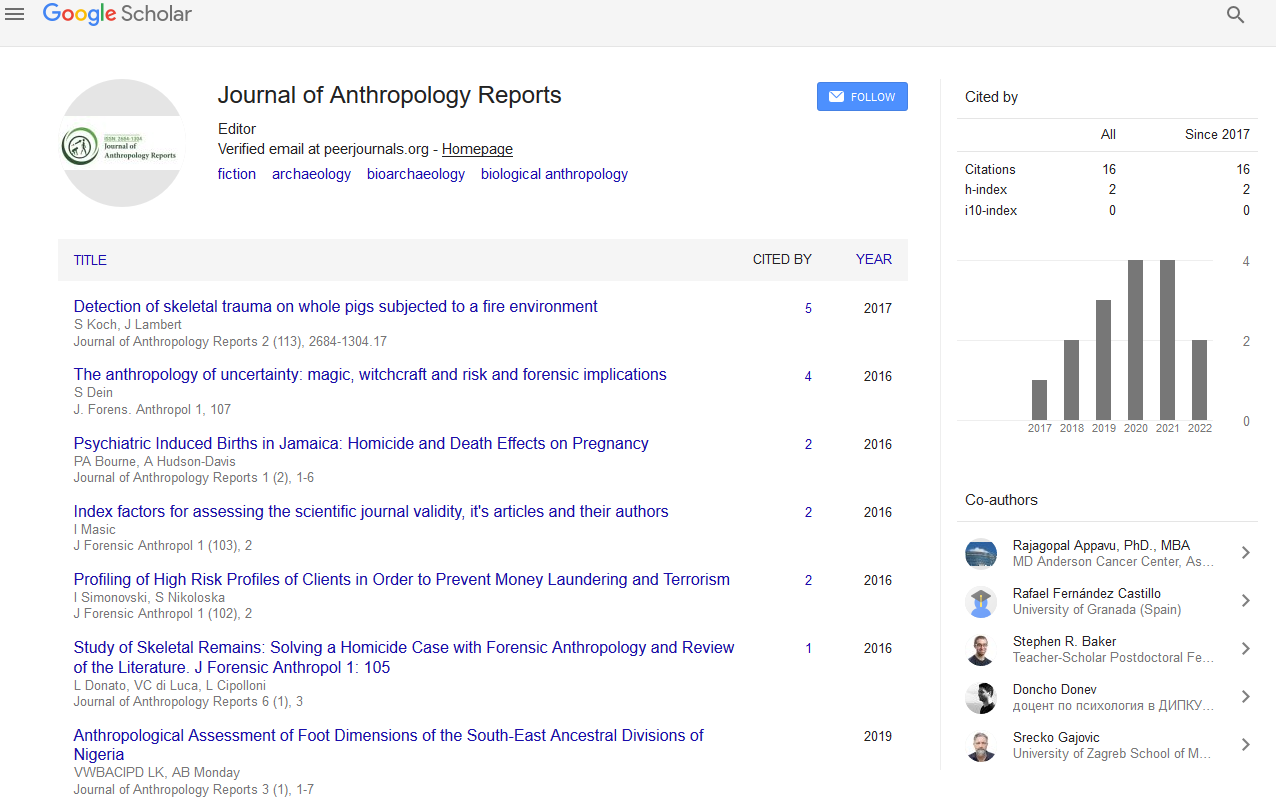Indexed In
- RefSeek
- Hamdard University
- EBSCO A-Z
Useful Links
Share This Page
Journal Flyer
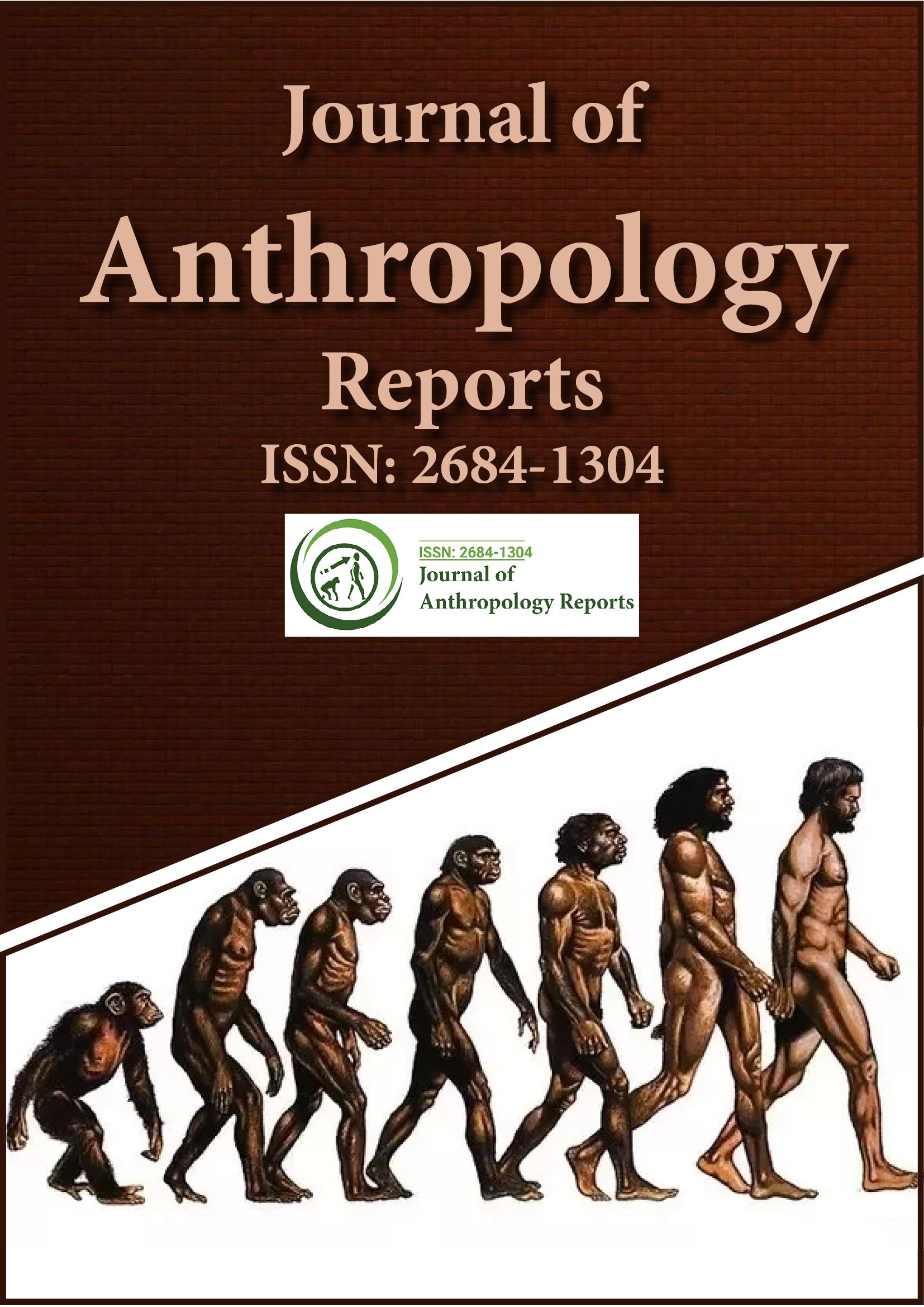
Open Access Journals
- Agri and Aquaculture
- Biochemistry
- Bioinformatics & Systems Biology
- Business & Management
- Chemistry
- Clinical Sciences
- Engineering
- Food & Nutrition
- General Science
- Genetics & Molecular Biology
- Immunology & Microbiology
- Medical Sciences
- Neuroscience & Psychology
- Nursing & Health Care
- Pharmaceutical Sciences
Research Article - (2023) Volume 6, Issue 4
Origin of Conjuring: An In-Depth Analysis of the Historical, Psychological and Anthropological causes and Consequences of the Rise of the Art of Magic
Luca Bettoni*Received: 15-Nov-2023, Manuscript No. JFA-23-23927; Editor assigned: 17-Nov-2023, Pre QC No. JFA-23-23927 (PQ); Reviewed: 01-Dec-2023, QC No. JFA-23-23927 (QC); Revised: 08-Dec-2023, Manuscript No. JFA-23-23927 (R); Published: 15-Dec-2023, DOI: 10.35248/2684-1304.23.6.172
Abstract
We know that the art of magic has its roots in ancient times, but due to multiple factors, the causes and dynamics that led to the advent of this art form remain unknown to this day. This research paper investigates this phenomenon by discovering for the first time how conjuring rose, not as an art form but as a tool apt to support hierarchical- pyramidal social structures. The results obtained from the analysis of historical, anthropological, ethnological and psychological sources and research, showed that the phenomenon of magic proved crucial in overcoming the hunter- gatherer societal model and ensured that the hierarchical-pyramidal model remained as such, motivating its legitimacy. Its development in the presence of certain religious and social changes in different places and times around the world demonstrates the profound and crucial evolutionary character of the phenomenon that developed as are-adaptation of the survival instinct in changed social conditions.
Keywords
Conjuring; Evolution of human societies; Historical studies; Anthropological studies; Modernization
Introduction
Today, conjuring is merely a form of art that, as such, is for its own sake. It has no impact on global changes, it does not substantially change social paradigms, and no revolution depends on it. The reality, however, teaches us that the world is a place in which everything changes shape, and so has been the case with the art of magic.
If we stated that society, as we know it today, could not have existed without the rise of this discipline, how would you react? What would you think if we heard that the massive progress and human development in every field could be traced back to the birth of the conjuring? To understand this, it is necessary to look from a new point of view, starting with the assumption that the art of magic has not, for several millennia, been an art form but an instrument. The illusion was used as an advantage for those who knew against those who did not, not so much from a conspiracy perspective but from an evolutionary framework.
This research began, initially, with the goal of identifying some ancient testimonies of sleight of hand, but as time went on, comparing and collecting data made it apparent that there was much more behind it. In disbelief of the results obtained, a veil of Maya unraveled and showed that what is now an artistic discipline once made it possible for man to move from a “state of nature” to the world as we know it today. From now on, we will use the world magic with the meaning of the performing art, not referring to magic as occultism.
Materials and Methods
The results obtained from the present research are the direct outcome of the comparative analysis of studies, historical sources and analyses in the fields of psychology, anthropology, ethnology, history and the history of magic. The results obtained are not to be found in any of the texts consulted, but come from the cross- referencing of data and evidence known to date.
The need to follow this approach emerged due to the lack of historical sources prior to 2500 BC. The data collection process has developed in multiple stages over the past four years.
In a first moment I collected all the data from the history of the art of magic and at the moment in which I realize that it was not possible to go further the only option left was to looking for some testimonies related to the ancient religion field: history, evolution and correlation of different religions [1-16]. To analyse more in detail some specific aspects and in order to look for more testimonies has become necessary to collect other data from some cultural aspect of specific civilization, topics that could be found in the anthropology and ethnology fields. At the end to comprehend the causes of come cultural changes I examine the sociological [17-23], psychological and psychotherapeutic field.
The aim of this research since the beginning was to analyse on a deep level the history of the art of magic. As soon as it was clear that this was not a phenomenon isolated from the cultural aspects of the history of humankind, a cross analysis of different branch of knowledge was the only way to go.
This was the most difficult part of the research because the cross-referencing of all the collected data was on two level:
• Analysing the evolution of certain social, cultural and religious phenomena for certain populations.
• Analysing the advent and evolution of specific phenomena at specific stages in the social, historical and cultural evolution of various populations (e.g. the advent of certain social changes in the transition from a hunter-gatherer society to a hierarchical-pyramidal society)
With these two levels of analysis in mind, it was necessary to find meaningful correlations of the phenomenon of magic.
For this research paper, all correlations of social and cultural phenomena that could be found (albeit in different forms, given the different cultures) in different historical periods and in different peoples many times over were considered significant.
Correlations between peoples who never came into contact either temporally or physically due to the distance of the continents were analysed with great care.
Premises of the research
This research paper aims to find out more about the origins of the art of magic, the past of which is surrounded by doubts and questions. Up to now, most books on the history of magic have only reached a few fragmentary testimonies from the Egyptian civilisation [24-29].
It has never been possible to go deeper into the origins for two fundamental reasons:
• In ancient times, there was no division between the art of magic and occultism.
• The difficult understanding of historical sources and their fragmentary nature (or often total absence) made any investigation impossible.
Although these two limitations are objective, what emerged during the search for ancient information was that the phenomenon of conjuring is much more complex than it has always been considered.
Moreover, the phenomenon was analysed from a macro perspective, thus not considering one or a few specific com munities within a short time period but considering all major human civilisations from the advent of homo sapiens (200,000 B.C.) until the 5th century A.D.
Results
The cross-analysis of the many sources and research considered in this paper led to the identification of three main findings:
• Presence of different types of magic
• Close correlation between the advent of magic and hierarchical-pyramidal social structures
• Strict correlation between the advent of magic and the change of certain founding religious paradigms of the most ancient civilisations
Presence of different types of magic
The results of the analysis of historical sources led to the identification of three types of conjuring based on the methodologies used to create the illusion.
• This is mainly based on the use of mechanical mechanisms of various kinds or, in some isolated cases, of manipulative skills.
• This is based on the knowledge of predicting natural or astronomical phenomena and how they work.
• Based on the deliberate alteration of one’s state of consciousness to “simulate” a divine possession.
Close correlation between the advent of magic and hierarchical-pyramidal social structures
An in-depth analysis of ethno-anthropological and historical studies has led to the recognition of a close correlation between the advent of magic (in one of its three forms) and the type of social structure.
Indeed, the results show that the advent of the art of magic is linked to the advent of hierarchical-pyramidal social structures. Moreover, no form of magic could be traced within huntergatherer social structures.
Close correlation between the advent of magic and the change in certain founding religious paradigms of the oldest civilisations
In connection with changing social structures, magic manifests itself in correlation with the change of certain founding religious paradigms in the cults of hunter-gatherer societies.
• Man began to consider the divine and earthly worlds as separate places.
• Man begins to conceive the concept of perfection, which arises due to the paradigm of splitting of the worlds. Perfection is proper to the divine world and corruptibility and imperfection to the earthly one.
Discussion
Having set out the results achieved, let us go into more detail about each of the aspects related to this research. For ease of understanding, we will divide the discussion into the following subgroups in this discussion as well:
• The three types of magic
• Social and religious changes
• Analysis of the concomitance of social-religious changes with the emergence of magic
• Psychological causes underlying the advent of magic
Definition of conjuring
Before analysing the causes and impact of the rise of a human phenomenon such as conjuring, it is necessary to understand it fully.
In modern times (and, in particular, since the 18th century A.D.), we speak of the art of magic to place this human phenomenon within a clear artistic dynamic that, by its very nature, is an end in itself. Based on the written testimonies that have come down to us [30-43], we can affirm that conjuring, for several millennia, did not play the role of an artistic form [24-26,28] but was a set of technical knowledge (and not only) aimed at the creation of phenomena that appeared supernatural or divine in the eyes of observers.
The techniques behind the illusion
Today, we know that, from a purely technical point of view, sleight of hands (often for small illusions) and mechanical-type devices (often for large illusions) are used as the basis of the illusion. Obviously, this is a simplistic definition, but we can identify the manipulative and mechanical elements as fundamental to the pure technique.
As can be seen in Figure 1, if we consider conjuring as a human artifice (apt to creation an illusion of supernatural powers), which is the result of machinery, gears and manipulative skills alone, we can only find evidence of it on the European continent and in areas of the Middle East [30,36-38,42].
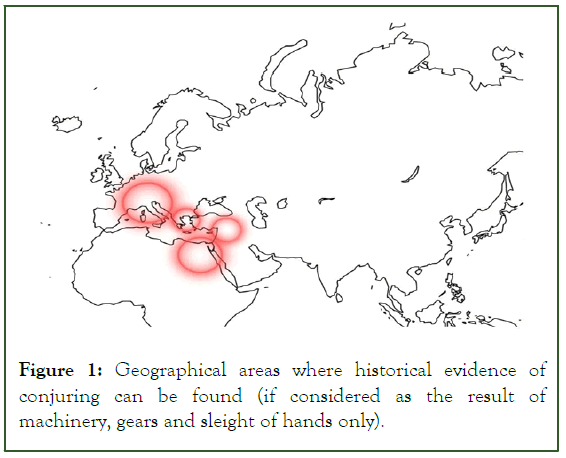
Figure 1: Geographical areas where historical evidence of conjuring can be found (if considered as the result of machinery, gears and sleight of hands only).
If, on the other hand, we consider conjuring simply as a human activity (apt to create the illusion of supernatural power, but not necessarily through the exclusive use of mechanical systems and manipulative skills), the scenario changes considerably as shown in the Figure 2.
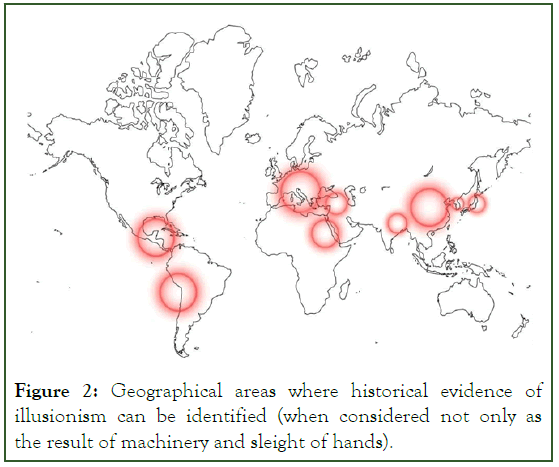
Figure 2: Geographical areas where historical evidence of illusionism can be identified (when considered not only as the result of machinery and sleight of hands).
The three types of conjuring
Using techniques as the fundamental distinguisher to classify the various forms of conjuring, we can identify three subgroups that we analyse below in their characteristics.
Technical conjuring: Definition and geographical distribution: We address technical conjuring by referring to the use of the aforementioned technical-manipulative expedients. Its geographical distribution can be mainly located in the areas of the Mediterranean basin, as shown in the Figure 3.
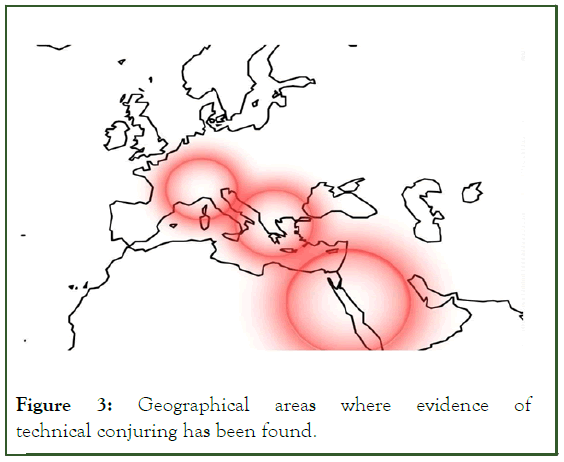
Figure 3: Geographical areas where evidence of technical conjuring has been found.
Testimonies and characteristics: One of the main historical sources that contains multiple evidence of the artifices of this type of magic is the work of Heron of Alexandria: Spiritually (Pneumatics) [34]. This work dates back to the 1st century A.D. and collects a whole series of machines and gears that work through the physical principles of pressure.
More or less consciously, Heron illustrates the operation of various machines suitable for the creation of various illusions, including:
• Heavy doors of times that open by themselves
• Crying statues
• Fountains that flow milk and wine
• Statues of speaking deities
• Voices from nowhere audible within temples
• Amphorae and craters that cannot be filled/emptied
Staying within Heron’s works, we find similar machinery in his works such as Automata, Catoptrica and Mechanical [35].
Other significant written sources that have come down to us are:
• Mechanical Syntax by Philo of Byzantium (3rd century C.E.) [41].
• Philosophically, the control against all sects work from the 3rd century C.E. better known as “Refutation of all heresies” [42].
As can be clearly seen in the images below, the tools used for creating the illusion are purely mechanical in nature as shown in the Figures 4-7.
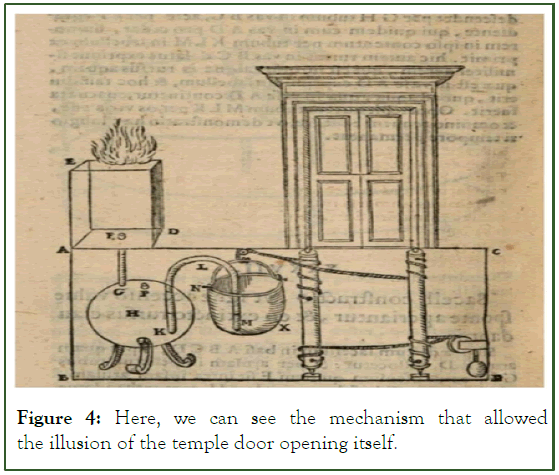
Figure 4: Here, we can see the mechanism that allowed the illusion of the temple door opening itself.
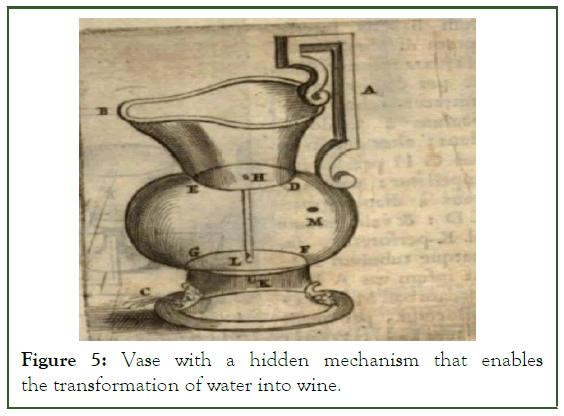
Figure 5: Vase with a hidden mechanism that enables the transformation of water into wine.
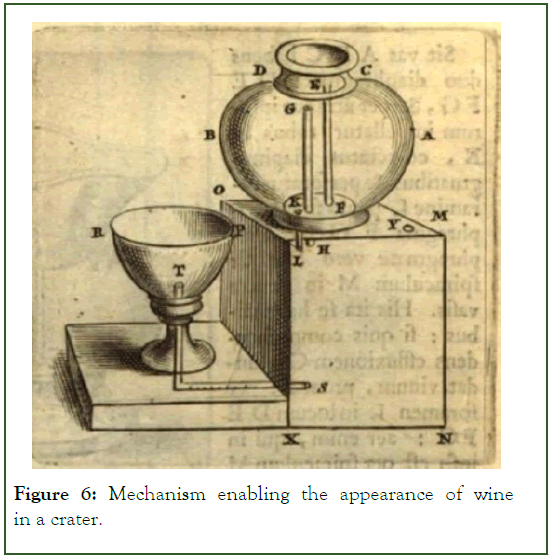
Figure 6: Mechanism enabling the appearance of wine in a crater.
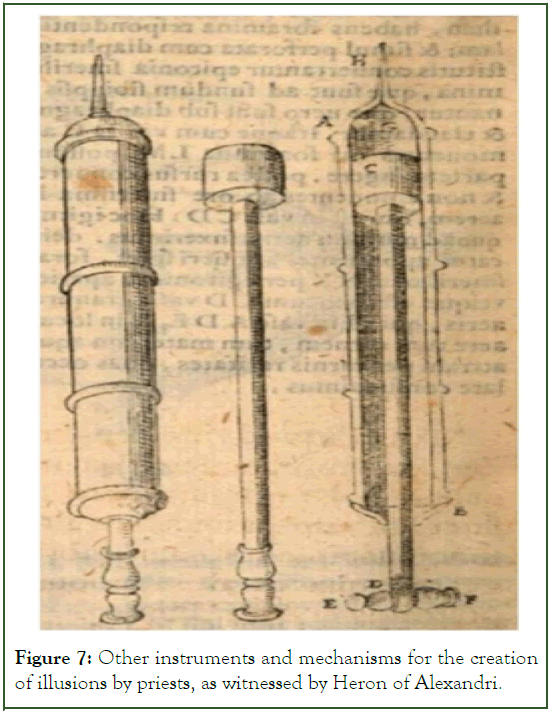
Figure 7: Other instruments and mechanisms for the creation of illusions by priests, as witnessed by Heron of Alexandri.
Dating and advent: The historical source material that, to date, has come down to us gives the earliest evidence of technical conjuring in 2500 B.C. during the reign of Pharaoh Cheops (see note point 1). We can base this result on the accounts that have come down to us from the Westcar Papyrus [43], accounts, which, beyond the probable mythicisation of some events, testify to the phenomenon’s presence at that time.
Given the mention of such events in writing, we can assume that the art of magic was not something new but had already been widespread for a long time. Given, however, the lack of reliable historical sources that unequivocally testify to its presence, we consider, with these premises in mind, 2500 B.C. as the date of the advent of technical conjuring.
Phenomenal conjuring
Definition and geographical distribution: As seen in Figure 8 below, the geographical areas involved increase if we consider the use of natural and astronomical knowledge to create the illusion. The most relevant natural phenomena to which we refer are those of an astronomical nature and, more specifically, given their notability, solar and lunar eclipses.
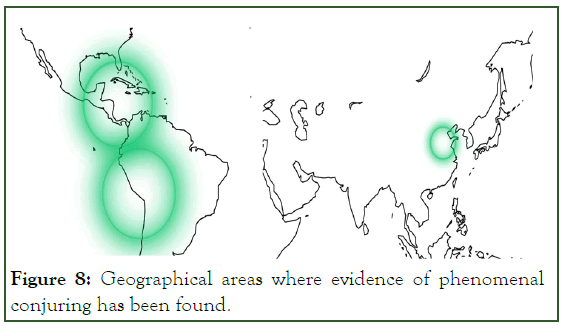
Figure 8: Geographical areas where evidence of phenomenal conjuring has been found.
Testimonies and characteristics
The focus on astronomy: As evidenced by ancient archaeological findings, we can see that since the dawn of time, human beings have always turned their gaze toward the heavens and have acquired considerable astronomical skills over the millennia [44-60].
One of the oldest sources testifying to this is undoubtedly the ivory tablet found in 1979 in a cave in the Ach Valley (Germany) [47]. This ancient artefact represents, in fact, the constellation Orion and, from the results obtained from carbon dating, is between 32500 and 38000 years old.
Attention to the celestial world, however, over time has led to he learning of complex and advanced knowledge, as evidenced, for example, by the Warren Field calendar, dating from 8000 B.C., which stands as the oldest calendar found to date, the Goseck circle (5000 B.C.), the Nebra sky disk (3000 B.C.) and various other artefacts [48].
Solar and lunar eclipses: Noting that ancient peoples in various parts of the world had given considerable attention to the study of astronomy, it is now necessary to focus on the phenomenon of eclipses, which has been observed across the globe by every people and has often given rise to mystical-religious speculation. People of every age have always looked with interest and often with fear at the phenomenon of eclipses, as often recorded in chronicles of every age. The interesting element of this phenomenon emerges as various people first understand and then predict the phenomenon.
In the areas of Mesopotamia by the Assyrians, Babylonians, Chaldeans and various other peoples, over time, refined the study of eclipses as evidenced by archaeological findings (e.g., Tablet 63 Enuma Anu Enlil of Neo-Assyrian origin) and mathematical studies handed down through the centuries (e.g., The Synodic Revolution of the Chaldeans). Civilisations not too distant as those of the Egyptians, as witnessed by Diodorus Siculus (90-27 B.C.) and Plutarch of Chaeronea (46-125 AD) gave their attention to this astronomical phenomenon. It is very likely that even in earlier times, the Egyptian people could calculate the alignments of the stars, but, unfortunately, we have no evidence of this until the Ptolemaic period [49,54].
Among other major civilisations concerned, we can mention the Greeks, moving to the Far East, the Chinese, and in Central America, undoubtedly, the Maya and the Aztecs.
Rituals: Although eclipses were observed by every person, not all civilisations could fully understand the phenomenon and predict its occurrence. Central African people, such as the Batammaliba (located between present day Togo and Benin), understood that there was a link between the Moon and the Sun in the phenomenon of eclipses. Still, they were not able to understand it scientifically, as other people mentioned earlier [55].
As well as the Batammaliba, many others understood eclipses only partially, from the people of sub-Saharan Africa, such as the Mursi, Karo, Samburu and Masai, to the Eskimo tribes. Caught suddenly by the ominous celestial phenomenon, all of these communities, rituals and group prayers hoped that the sun would not disappear forever, which is completely understandable.
A more curious situation occurs among the Maya, Inca and Chinese civilisations. As we have seen above, in the populations just mentioned, the priests fully understood the phenomenon of eclipses and were also able to know when they might occur (see note point 2). Being aware of the cyclical nature of the phenomenon and knowing that the sun would not disappear since the eclipse was only the result of an alignment between the two stars, why mobilise the entire population to gather in collective prayers and rituals administered by the sovereign and minister?
Although the understanding of the Dresden manuscript is, in some aspects, still uncertain, an element of fear emerged clearly among the people (who had no advanced astronomical knowledge) in front of the darkening of the sun [56]. This, moreover, was confirmed by the chronicles of various Spanish conquistadores in the 15th and 16th centuries.
The people were obviously unaware that the phenomenon of a natural character was temporary and would pass, but what reason was it to keep the people in the dark about this? It would not have been necessary to explain the complex motion of the stars, but it would have been essential to reassure the people that eclipses were not dangerous.
If we look at this phenomenon from a slightly different perspective, we can see this as a huge magic trick. The people are asked to stop all work, gather collectively and chant prayers to help the sun in the celestial battle. The fear of the people increases when the sun is completely obscured. From the top of the pyramid, the priests and ruler perform sacrifices and bring offerings to the deities, and thanks to all this collective effort, slowly, the sun shines again. From the perspective of ordinary people, sacrifices and prayers cause the sun, engulfed by a threatening shadow, to shine again. Since eclipses, especially solar ones, were not that common, people were unfamiliar with the phenomenon, resulting in a lack of awareness of its natural cyclical nature. Religious rituals coordinated by the upper echelons of society were, therefore, the cause of the Sun’s return.
We have evidence of collective rituals in conjunction with a knowledge of the phenomenon by priests alone at Maya and Incas and in China [57,59].
Magic and natural phenomena: As we have seen, the minister class’s knowledge of the workings of a complex phenomenon could give rise to an enormous magic trick. We have dwelt here on the example of solar eclipses since they are a phenomenon that has been particularly documented and observed in all parts of the world. Taking awareness of this, it is possible that there were also other phenomena (astronomical or otherwise) predictable using scientific knowledge, which were used as magic effects.
In any case, given the need to investigate with a broad look encompassing every population in the world to compare data from different civilisations, we are not going to investigate other natural-type phenomena since the dynamics would be identical.
Dating and advent
Dating the acquisition of knowledge is something that borders on the impossible. We can consider dating the historical sources that testify to the knowledge itself, but of course, this will be inaccurate.
Conjuring of possession
Definition and geographical distribution: At the basis of this form of magic, we have a deliberate alteration of a state of consciousness through conscious actions that simulate the divine possession of the practitioner. As shown in Figure 9, below, this phenomenon is localised in the regions of the Far East and, more specifically, Tibet, China, Korea, Japan and Nepal.
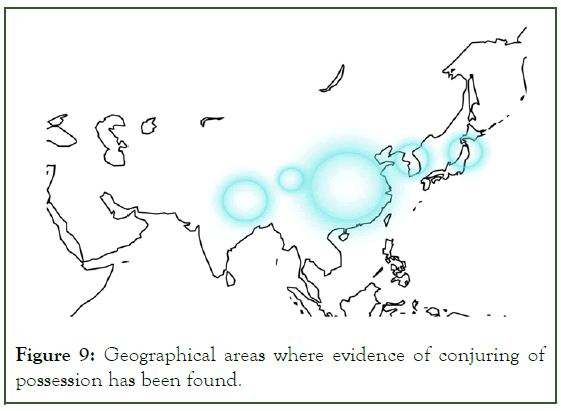
Figure 9: Geographical areas where evidence of conjuring of possession has been found.
Testimonies and characteristics: Among the three forms of magic, this, without a doubt, turns out to be one of the most complex since we step into articulated psychological dimensions, and, in this case, the operant's awareness is at a lower level than in the other two forms of magic (see the paradigm of perfection). Considering the phenomenon's complexity, which can still be observed in some communities today (see note point 3), let us now try to analyse what the illusion consists of, its basic characteristics, and the psychological mechanisms behind these processes.
Shamanism: Definition and characteristics
To describe the phenomenon of conjuring of possession, we enter the field of shamanism [9,16], which, from a history of religions, anthropology and ethnology perspective, is a complex set of religious beliefs and practices. The core of this socio- religious phenomenon, as defined by Boris Chiclo, is the figure of the shaman a man who becomes a conduit between the divine (spirit) world and the earthly world.
The shaman, however, is not a clerical figure who performs this single function within society and communicates with a divine world separate from the earthly world. The shaman is a religious figure that we also, and especially, find within hunter-gatherer societies, societies in which the division of labour is not sharp and defined [15].
Therefore, in such a context, the natural and spiritual worlds merge, and the shaman becomes a catalyser of the spirits of the dead, of ancient ancestors and of divine entities. From interviews by anthropologists in the early 1900s with shamans from Australia and various parts of Africa, we know of actual physical transformations of shamans into spirits (often animals in character).
Of course, we are all aware that there is no physical transformation within these practices, but there is an important inner transformation that we will analyse later.
Shamanism and conjuring
We mentioned in the previous paragraph that shamanism is a broad and complex category of cults found within hunter-gatherer societies. This might sound like nonsense since we have previously pointed out that precisely in these types of societies, magic did not rise, but it does not. Shamanism is not a religion but a vast container of cults different from one civilisation to another, and precisely because of this diversity, we can say that there are different types of shamanism.
Klaus E. Muller, in his work Schamanismus: Heiler, Geister, Rituale (Shamanism. Healers, Spirits, Rituals) [14], makes an interesting tripartition of the phenomenon, which we summarise below by quoting his own words.
Elemental shamanism: Widespread, especially in fishing societies and in hunter-gatherer societies. Among its characteristic traits The shaman's call is made by animal spirits, and his basic tasks are to ensure the success of the hunt, the health and the reproduction of the group; thus, overall, to control and care for the souls of animals and humans. To fulfil his tasks, the shaman makes use of the technique of ecstasy often with the use of auxiliary tools like drugs, special customs and certain ritual instrument.
Complex shamanism: Widespread, especially in adjacent transitional areas, i.e., among nomadic pastoralist groups in northern and interior regions of Asia and in horticultural societies in the tropics. Alongside the traditional tasks of the shaman and their execution through ecstasy and contact with the beyond, some new traits emerge, which can be traced back to (prevailing) sedentariness: often, the shaman responds to the call of the spirits of ancestors destined, later on, to assist him as personal protecting spirits. The bond with a personal adiutore spirit, whom the shaman reveres and cares for, and to whom, above all, he must periodically make sacrifices to ensure his benevolence and availability, becomes closer; libation offerings to other protector spirits are also practiced.
Possession shamanism: A syncretistic shamanism, characterized by a clear, though not exclusive, predominance of shamanesses. Unlike in "classical" shamanism, the shaman's soul no longer undertakes journeys to the afterlife; we are, therefore, no longer in the presence of ecstatic sessions but rather of sessions of possession: The spirit to which the shaman has devoted himself enters his body and, through him, heals or transmits information. However, what distinguishes shamanism from other "possession cults" is the fact that the shaman, whenever a séance is imposed, has the power to voluntarily summon the spirit; that is, he is not, so to speak, taken by surprise and overwhelmed by it, and he is not a passive instrument of it.
Ecstasy and conjuring
One element that recurs within these arbitrary types of shamanism identified by Klaus E. Muller is the element of altered state of consciousness, which, however, takes on a particular aspect in possession shamanism.
“The shaman, whenever a session is imposed, has the power to voluntarily summon the spirit."
This is the element that characterizes shamanism that has developed in various parts of the Far East: the intention of the operator to be "possessed" by the deity [16]. Here, and only here, we can identify a form of magic since the operator decides to voluntarily execute a series of processes that alter their state of consciousness (without using drugs). From the point of view of the observant, this is concrete proof that deities do really exist [60]. We should remember that the division between the divine and material worlds is partial in this socio-religious context. Thus, a division begins to be created (albeit still only partially) between physical and subtle entities.
The shaman, in fact, begins to assume a fixed figure at the top of the social structure, being a conduit between deities and humans. A possession (at will) is concrete evidence that the shaman can communicate with the divine for real, confirming the separation between worlds and the hierarchical superiority of the divine world over the earthly.
An interesting aspect is how it is possible for civilisations who have never met each other to manifest a form of conjuring of possessions by spirits of animals (often the totemic spirits, from which, according to tradition, the clan is derived), spirits of ancestors or other forms of deities. We enter here into the complex and intricate field of psychology and neuroscience, and we will analyse, step by step, the elements of our interest shortly to understand the phenomenon fully [13-15].
The trick: Raĭkov's studies
Some people seem to be able to transform themselves into animal figures, make contact with deceased people and let divine spirits enter inside their physical bodies: Is all this true? Yes.
We can affirm that the phenomenon is true on a phenomenological level for those who experience such a phenomenon of voluntary pseudo-possession. To understand how all this is possible from a neuroscientific point of view, it is necessary to enter the meanderings of psychotherapy, particularly the studies, often little known at the general level given their complexity, of Vladimir Ra kov (1934-2007).
In the USSR of the 1970s, the psychotherapist Ra kov, in Moscow, conducted extensive studies and experiments on altered states of consciousness. Ra kov's studies led to the hypnotic technique that is now known as DTI (Deep Trance Identification) [60-63]. This technique is a process of inductive modeling wherein the modeler utilizes hypnotic trance as the primary learning process. In hypnosis the modeler will associate into the model and experience the world through the perspective of the model including the model's states, thoughts, beliefs, and values [64-67].
Quoting the book: Deep Trance Identification: Modelling and Mastering the Unconscious for Hypnosis Practitioners, Coaches and Ordinary People, written by Shawn Carson, Jess Marion and John Overdurf [60]:
“In the 1960s Vladimir Raikov began conducting hypnotic experiments designed to improve the musical abilities of students at the Moscow Conservatory. His experiments consisted of 3 groups, a control group of students who were not hypnotized, students who were hypnotized and received positive suggestions, and students who were hypnotized and were taught to "be in the skin of" some of the great musicians throughout history. Students who were in the third group scored significantly higher on their exams in both technical proficiency and artistic interpretation.”
The psychological process behind DTI, explains the secret behind the conjuring of possession. Through various techniques, the practitioner enters a state of hypnotic trance and, in that state, directs all mental forces toward the subject they want to embody (the spirit or deity). A process of unconscious and profound identification is then established on the part of the operant, who, for all intents and purposes, becomes (in their personal experience) possessed. On an external level, ordinary people see a person who, on command, can change his voice, speak in other languages (or what appear to be other languages), demonstrate the absence of physical pain and much more.
The element of magic, here, is in the first part of the phenomenon: the operant, the shaman, consciously chooses who to identify with, when to do so and what characteristics to embody of the role model. An aspect that complements and corroborates this dynamic is one of the data observed by Klaus E. Muller for these phenomena of shamanism: the fact that the shaman, at this stage, decides to devote himself to a single-spirit god with whom he forms a close relationship. Indeed, the results obtained from Dr Ra kov's experiments show that a key element for deep identification in a trance state with the role model is deep knowledge of the characteristics one wishes to embody.
Dating and advent
Defining precise dating and advent for a practice such as the conjuring of possession is something that is, by its very nature, extremely complex. Referring back to Muller's studies, we do not find dates when the phenomenon of shamanism became wide and varied, and, therefore, such discourses can only be made about small geographical areas or populations (however, it is not always easy to find numerous and detailed historical sources to make a complete and vertical analysis).
Social and religious changes
Now, having analysed in detail all the characteristics of the various forms of magic that have developed throughout the early history of human beings, let us enter the historical path that led particular communities to develop this phenomenon.
Here, we will simply observe the social and religious changes in each aspect. We will only address the motivations and causes that led to such changes at a later stage. The types of changes we will analyse are of two basic types: social and religious.
Social changes
The social changes we refer to in connection with this research are related to the change in social structure within human communities and, more specifically, in the transition from hunter-gatherer (see note point 4) societies to a hierarchical- pyramidal society.
By hierarchical-pyramidal societies, we refer to all those societies that develop according to hierarchical logic with a ruler (or a group of powerful people) at the head. In a pyramidal scheme, it is possible to identify multiple social roles of decreasing importance.
Hunter-gatherer societies: In a hunter-gatherer society, communities of humans live in a sort of “state of nature” in which we identify these characteristics:
• There is no high division of labour.
• Social hierarchies are minimal and of biological-natural characteristics.
It is also possible to identify many other characteristics in this type of society, but the mentioned aspects are of interest to this research.
There is no high division of labour; this first characteristic describes itself, and there is little clarification to be made. In this type of society, each person held several different roles, and there was no concept of “doing only one specific job”, which would follow as the social structure evolved. The only element of the division of labour might have been related to the sex and age of the individual, although these divisions were not always sharp and separated [9-15,68-75].
Social hierarchies are minimal and biological-natural. In the context of the absence of specialisation, it is not possible to identify highly complex social hierarchies. This, of course, is connected with the rate of division of labour. Since each individual is required to perform multiple different and separated roles and jobs, a complex social hierarchy can’t be created as there are not many separate roles present [9-15].
Again, the minimal social hierarchy that is created in some cases (but this is not always clearly found) is related to biological-naturalcharacteristics. Leading a given community may be the village elder. Cases of patriarchy or matriarchy can be identified [9-15].
Hierarchical-pyramidal societies: The evolution of social structures leads to many changes that affect the two basic aspects we addressed in the previous section (see the social changes). As time passes, with consequent development of new technologies, skills and activities suitable for survival and subsistence, the division of labour increases. Humans then begin to perform more specific tasks. Consequently, the social structure becomes more complex (partly because the specialisation of labour fosters faster progress that makes possible the creation of numerically larger communities of men) [15-70].
Therefore, the biological-natural character proper to hunter- gatherer communities is gradually lost in this context. This does not mean that the biological-natural character has no weight and disappears altogether, but other factors that influence the division of social roles are added. Societies are, therefore, more complex, and at the top of such a society is no longer an individual leading the community by characteristics of sex or seniority. Social roles become more arbitrary at each level of the social scale, and it is not possible to find objective differences between a ruler and a slave who are at the antipodes of the social hierarchy. [15,70-76].
Religious changes
As mentioned in the first section of this research, the two main religious paradigms that have changed in correlation with the rise of conjuring are the Paradigm of the splitting of the worlds and the Paradigm of perfection.
Paradigm of the splitting of the worlds: This division between the divine and earthly worlds takes on different connotations according to geographical areas. The sharper the separation between the two worlds [1,9], the higher the awareness of the operator of the illusion, who is more or less aware that there is no supernatural intervention in the illusion he created. We can see a distribution of the different degrees of awareness of the operants in Figure 10.
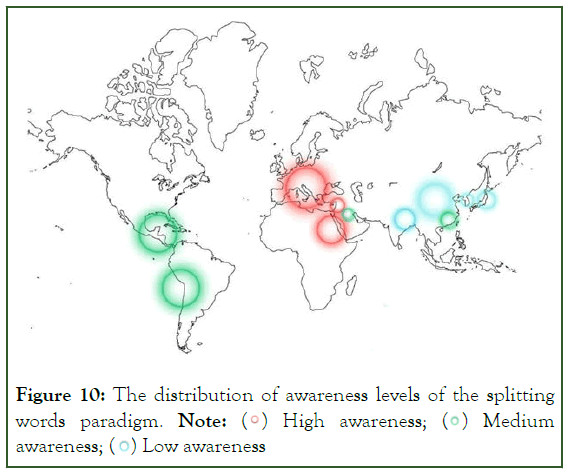
Figure 10: The distribution of awareness levels of the splitting
words paradigm. Note:  Medium awareness;
Medium awareness;  Low awareness
Low awareness
Paradigm of perfection: Mirroring the distribution of operant awareness is the entrenchment of the paradigm of perfection, which is derived from the prince paradigm. The greater the entrenchment of the belief that there is a divine world utterly separate from the earthly world, the greater the belief that there is a “perfection” that takes on transcendent connotations proper to a haughty world (the divine world) as opposed to the immanence of the earthly world [1,6,9-15,70].
Social impact of religious changes
As a result, these two paradigms change two fundamental social dynamics:
• The man-god relationship
• The perception of the divine world
Hunter-gatherer societies: The human-god relationship in these communities is an intimate and personal one. Since there is no high division of social roles, it is impossible to identify a figure of a minister fully dedicated to the relationship with the divine. Each person has their own relationship with the spiritual world, and even if rituals of a collective type led by a specific figure are done, that individual performs not only that function in society but also a variety of others.
On the other hand, perception of the divine world is a concept that does not exist in hunter-gatherer societies since there isn’t any divine world or human world separated from each other, but there is only one world. The spiritual and material dimensions are concepts conceived separately only later. Since there is no hierarchical social structure, there is no concept in an individual’s everyday experience that there is “someone higher” and “someone lower”, but we are all on the same plane.
Similarly, the divine world is not perceived as something separate and distant but as something connected with the natural environment in which humans live. Such a paradigm, moreover, is corroborated by the fact that the relationship with the divine is intimate and personal; prayers, libations, rituals, etc. are performed without intermediaries (even in the case of group rituals, the one who leads the ritual is not considered as a go- between man and god, but as a man who simply coordinates the whole ritual).
Hierarchical-pyramidal societies: However, the human-god relationship in this context changes as the division of labour increases. As increasingly distinct social roles and jobs emerge, the priestly figure becomes a fixed presence. He or she who leads the community during a religious ritual begins to deal only with divine matters. The relationship with the deity begins to be increasingly detached since now between the common man and the deity there is a mediator: the minister.
Since daily existence develops according to hierarchical logic, the perception of the divine world is the perception of a haughty and separate world that assumes higher importance than the human world. This importance, moreover, is given by its inaccessibility since access to the spiritual world requires an intermediary found in the figure of the minister.
This figure, therefore, assumes a role of superiority on the social scale since it connects the two worlds. In this period, religious organisations began to emerge, having their own hierarchy with the faithful at the base and, progressively, priestly positions of increasing importance. Social structures, such as religious organisations, are not found, in fact, in hunter-gatherer societies since, in such contexts, these are not the necessary requirements for their advent.
Analysis of the concomitance of social-religious changes with the rise of magic
An interesting element to consider in this analysis context is the concurrence with the social and religious changes we have analysed and the rise of magic. This phenomenon, therefore, takes hold with the advent of the following characteristics:
• A pyramid-type society: We have no experience with any of the three types of conjuring in hunter-gatherer societies.
• The presence of a priestly figure and an external god: This is because conjuring aims to give evidence of the existence of a higher (divine) force, and the intermediary between two worlds is the priest figure.
These, however, are just findings that we can draw from historical sources, but why did this happen? What are the causes that led to the emergence of this phenomenon? How are these causes related to the social and religious dynamics of hierarchicalpyramidal societies?
Causes behind the advent of magic
We are all aware that every human phenomenon has one or more causes behind it. However, in some cases, it is not necessary to conduct profound research to understand the causes, either because the phenomenon is simple or because the causes are obvious.
Nevertheless, in phenomena as complex as the one we are dealing with in this research, things change even more since we are talking about a phenomenon that has developed globally but not in all people. If we take, for example, the emergence of myths and legends, we can certainly speak of a phenomenon articulated and developed globally, the causes of which can be easily identified.
The phenomenon of conjuring, on the other hand, is a slightly different case, as its distribution has covered several civilizations in different places and times, but its geographical distribution is (apparently) not logical. It is clear that the causes that led to the rise of the magic phenomenon can be found in all the people concerned causes that were not present in all other civilisations that did not develop it. What, then, are these causes?
There are two types of causes underlying the advent of magic in its various forms:
• Historical and local causes (secondary causes)
• Psychological cause (primary cause)
Historical and local causes
We will not overextend this category of causes, which, as indicated earlier, are of secondary nature, since they would not have been sufficient for the advent of magic. Historical causes refer to the individual civilisation or people who developed a given type of conjuring. Profound astronomical knowledge is a cause of historical and local character for the Maya and the Incas that caused a phenomenal form of conjuring to develop. The various people of the Mediterranean Sea, where magic of a technical nature developed, contributed to this development and undoubtedly developed skills and knowledge in the field of engineering that contributed to the development of machines.
However, we cannot consider these as the leading causes behind the development of the phenomenon since, taking up the example just given, the Maya and Incas should also have developed a technical type of magic since they themselves had excellent knowledge in the field of engineering. We can attribute this cause to the type of magic that came to develop, whether technical, phenomenal or possession conjuring.
Psychological cause
We now get in touch with the real cause that led to the rise of magic, which is closely related to the evolution of the social structure. Magic developed only when humans abandoned the social model of hunter-gatherer communities.
Definition: Conjuring arose in response to the manifestation of the survival instinct, which, in a hierarchical-pyramidal social context, is configured with the tension of moving up the social pyramid (for those at the bottom) or remaining at the top (for those already at the top).
In this new society, individuals at the top of the social pyramid do not hold that position for biological-natural reasons (as in hunter-gatherer societies) but for arbitrary reasons [17-23,77]. To avoid social conflicts, fictitious motives organically emerge, which (in most cases) bind the highest rungs of the social pyramid to the divine world.
Let us remember, in fact, that in this context, due to the specialisation of labour and the consequent emergence of the figure of the minister, the relationship with the divine is demoted from an inner and individual relationship to an external one with the help of an intermediary [9-15]. Thus, by placing the deities above every man, the decision (or apparent decision) of the god to choose one or more persons could, in no way, be questioned by people. To give proof of this actual bond, magic arises, which is the concrete and tangible proof that there are omnipotent and omnipresent deities.
In-depth exemplification: Let us try to simplify with the help of some practical examples.
As we have seen in the previous paragraphs, as time goes by in some communities, this kind of state of nature is abandoned, and the human being within his community no longer performs multiple tasks but specialises in a given job. Specialisation accelerates the technological process, and consequently, many dangers that threaten human beings’ survival disappear or are drastically reduced.
A community of humans living in a purely natural setting and sleeping inside natural shelters live with the danger of being attacked by some ferocious animal during the night. In the same context, to survive, it is necessary to hunt wild animals; otherwise, feeding is not possible. In such a situation, therefore, we can say that health and physical strength are the only two basic elements for survival.
If, however, we move our focus to a community that developed a more complex societal structure, the division of labour led to the creation of dwellings and fences, almost totally reducing the danger of being attacked by vicious animals. Similarly, the specialisation of labour favoured the raising of livestock and cultivation. To feed oneself, therefore, one need only goes to the market or buy animals to raise.
In the second situation, it is clear that strength and physical health are certainly two elements that contribute to human survival, but they are not the only ones. Another key element becomes the social position held by the individual. It is clear that a ruler or a priest has a better chance in life than a beggar. This is because he can live a better dwelling, eat more, etc. The survival instinct, in this new social context, manifests itself no longer in the search for a sharper weapon or more hidden shelter but in trying to move up the social pyramid (for those at the bottom) or trying to stay at the top of the social pyramid (for those already at the top).
However, the tops of the social pyramid have lost that biological- natural character proper to hunter-gatherer communities, but the roles are arbitrary. It is not the eldest in the kingdom who is sovereign or the father with the most children, but a random person. In a pyramidal society, it is clear that there is no biological-natural difference whatsoever between the son of the king (who will, in turn, become sovereign) and the son of a slave (who, with much more difficulty, will be able to scale the social pyramid). Since there are no natural differences, new differences are thus created, often of a religious nature. The ruler is such because he is the son of the Sun God, or because he is of ancient divine descent, or because a higher spiritual force chose him.
How is it possible, however, to really give proof of this? It is necessary to demonstrate concretely before the eyes of the whole people that there are higher deities who can do the impossible, such as open temple doors, make the sun shine again or take possession of the bodies of shamans.
The limits of this research
In concluding this paper, it is worth noting that there are, as in any research, limitations, which, in this case, are related to two key areas:
• The complexity
• The sources
First, the already mentioned complexity inherent in the research itself turns out to be a limitation. Indeed, it was necessary to analyse phenomena that are already complex in themselves (such as changes in social structures) by taking ethnological, cultural, anthropological, evolutionary, sociological and psychological aspects (analysed, compared and intersected with each other) applied into consideration, moreover, to a global perspective.
With these premises, it is evident that it is possible to understand and observe these events on a macro level, having to set aside any exceptions and differences related mainly to small populations. Having a strong historical character in this research, another limitation is, without a doubt, the problem of finding sources, which often, in such remote eras, are partial and difficult to understand. This corroborates the need to observe the phenomena at a broader level without going into specific individual details since often this would simply be impossible for many populations [78-83].
Conclusion
At the beginning of this research, it was mentioned that the two fundamental limitations that, until now, have made it impossible to discover the most ancient origins of the art of magic had been the testimonies (which are fragmentary and difficult to interpret) and the discernment between conjuring and occultism.
However, the results obtained from this research do not come from the direct resolution of these two challenges but from a different approach taken to arrive at the resolution of the same research question. A fundamental characteristic of this investigation was the combination of different fields of study, which made it possible to analyse the phenomenon of magic from various points of view by understanding its complexity and characteristics. If the obstacle of ancient sources testifying to conjuring was solved by drawing on other fields of study, the problem of discerning between magic as an artistic form and magic as occultism would have disappeared in itself. As we could see from the results obtained, we had confirmation that a new and thoroughly developed form of magic was used as a tool.
Beyond the methodological characteristics of this research paper, the most important element is undoubtedly the implication of the results obtained. Magic turns out to be a human phenomenon that assumes a fundamental role within an evolutionary perspective. The cornerstone that made the transition from a state of nature to a complex and hierarchical society possible was magic. Moreover, technological, scientific, and every field of human development derive precisely from this change in the social order.
Of course, this research does not claim that magic was the only element that made all this possible, but it was certainly a fundamental building block that, in different ways, in different places and at different times, made possible the advent of society as we know it today. However, we must make it clear that we do not view this phenomenon from a ‘conspiracy’ perspective where the priests of each civilisation decided to create illusions to consolidate the belief that there was an external divine way that legitimised the pyramidal social structure.
Instead, this phenomenon should be seen as an anthropological dynamic that developed naturally. This is a necessary phase in the evolution of human societies, as demonstrated by the development of this phenomenon in cultures and peoples that have never met each other.
Notes
• In the interest of fairness, I would like to point out that in the time frame considered, we also have some evidence of the use of magic that comes closest to an art form. Specifically, we have evidence in the Egyptian world with the Westcar Papyrus (circa 2000 B.C.) with the performance of the Magician Djedi and in the biblical account contained in the book of Exodus with the confrontation between Aaron and Moses and the magicians of Pharaoh. We can equate such tales with an artistic discourse since the figure of a performer, who exhibits illusions upon request, is present. It is equally crucial to point out that, however, the figure of the magician remained the figure of a person who practised occult practices and not that of an artist, and, therefore, such performances were still considered to be the result of non-natural powers. A final piece of evidence is found in the Greek language and in particular in the word voting player (voters), which referred to street performers who performed with the game of compasses (Figure 1). Psefopaiktes (literally players with pebbles) were not seen as endowed with supernatural or divine powers but as street performers (lumped, however, withe jugglers).
• To be more precise, we can state that Maya knew that eclipses can only occur at certain intervals, but they could not always predict precisely whether an eclipse would be visible in their territory. Anyway they knew that eclipses are cyclic phenomena.
• An example is the Phuket Vegetarian Festival.
• Giving an academic definition, we can say that under the common designation of ‘hunter-gatherers’ are those populations that do not practice any form of agriculture and animal husbandry, meaning that they do not have productive economies in the strict sense but of acquisition or harvesting.
Acknowledgments
The author would like to extend his sincerest gratitude for personal private confrontation to:
• Rogelio Valencia, (PhD Researcher)
• Jingtao Zhu, (PhD Researcher and Academic Director at ClicAsia, Centre d'Estudis Orientals)
• Chris Chiappari, (Professor (Associate) at St. Olaf College)
• Ivan Sprajc, (PhD Senior Researcher at Research Centre of the Slovenian Academy of Sciences and Arts)
• David Carballo, (PhD Professor (Full) at Boston University)
• Amitabhvikram Dwivedi, (PhD Professor (A) at Shri Mata Vaishno Devi University)
• Vicent Gimenez-Chornet, (PhD History Professor (Full) at Universitat Politecnica de Valencia)
• Joyce Marcus, (Professor (Full) at University of Michigan)
• Pablo Cadahia Veira, (MA in Chinese Philosophy, Religion, and Culture (CPRC) and PhD Student at University of Santiago de Compostela)
• Riccardo Moratto, (Professor (Full) at Shanghai International Studies University)
• Consuelo Pavanetto
• Sean Eckmann
References
- Auberg E. The zodiac conception date of the temple of Hathor in Dendera. BIFAO 1995;95:1-10.
- Graves K, Acharya S. The world’s sixteen crucified saviours Christianity before Christ. Adventure Unlimited Press. 2001.
- Davis KC. Don’t know how much about the Bible. William Morrow, 1998.
- Leedom TC. The book your church doesn't want you to read. Vancuver. 2001.
- Doane TW. Bible myths and their parallels in other religions. Commonwealth Co. 1882.
- Monaghan P. The new book of Goddesses & Heroines, Woodbury. Llwellyn Publications. 2002.
- Errico RA. Let there be light: The seven keys, Camarillo. Devorss and Co. 1994.
- Schott S. Urkunden mythologischen Inhalts nebst deutscher Übersetzung, Leipzig. 1929.
- Anati E. The origins of religion: A stuy in conceptual anthropology, Human Ecology. 2013;48:767-768.
- Bellah RN. Religion in human evolution: from the paleolithic to the axial age. Cambridge Belknap Press. 2011.
[Google Scholar] (All versions)
- Ciattini A. Antropologia delle religioni, Rome. Carrocci. 1980.
- Comba E. Antropologia delle religioni: Un’introduzione. Laterza. 2008.
[Google Scholar] (All versions)
- Donini A. Breve storia delle religioni, Rome. Newton Compton. 1959.
- Muller EK. Schamanismus: Heiler, geister, rituale, munich. CH Beck. 1997.
[Google Scholar] (All versions)
- Ember CR. Hunter-gatherers (Foragers). Explaining Human Culture. 2020.
[Google Scholar] (All versions)
- Yang M. Shamanism and spirit possession in Chinese modernity: Some preliminary reflections on a gendered religiosity of the body. Santa Barbara Brill. 2015.
- Artieri GB, Bentinvegna S. Le teorie delle comunicazioni di massa e la sfida digitale. Laterza. 2019.
- deBlasio E. Media, politica e società. Carrocci. 2017.
[Google Scholar] (All versions)
- Jamieson KH, Cappella JN. Echo chamber: Rush limbaugh and the conservative media establishment. Oxford University Press. 2008.
[Google Scholar] (All versions)
- Katz E. Lazarsfeld, personal influence. The Free Press. 1955.
- Luhmann N. La realtà dei mass media, Milan. Franco Angeli. 2000.
- McCombs ME, Shaw DL. The agenda setting function of mass media. Public Opinion Quarterly. 1994;36:176-187.
[CrossRef] [Google Scholar] (All versions)
- Necropolitics MA. Durham. Duke University Press. 2011.
- Luque J. Historia de la magia, el ilusionismo desde la prehistoria hasta la caìda de Roma, Madrid. Editorial almuzara. 2022.
- Tamariz J. The magic rainbow Madrid. Editorial Frakson. 2016.
- Hopkins AA, Evans E. Magic, stage illusions and scientific diversions including trick photography. Sampson Low. 1897.
[Google Scholar] (All versions)
- Dif M. Histoire et évolution technique de la prestidigitation: Sorciers, magiciens, escamoteurs, physiciens, prestidigitateurs, illusionistes, manipulateurs, Limoges. Impresor Lathiere et Pecher. 1974.
- Ennemoser J. History of magic, translated and edited by Henry G. Bohn. Wilson and Ogilvy Publisher. 1854.
[Google Scholar] (All versions)
- Nag S. Black magic, witchcraft and occultism secret cultural practices in India. Routledge. 2023.
- Apuleius, Butler HE. The apologia and Florida of Apuleius of Madaura, Translated by Butler HE. Clarendon Press. 1909.
- de Fato C. On fate and Boethius, edited and translated by RW Sharples, Liverpool, Aris and Phillips Classical Texts. 1992.
- Eunapius, Philostratus. Lives of the philosophers, edited and translated by Wilmer C Writght. Harvard University Press. 1921.
[Google Scholar] (All versions)
- Ginouves R. Dictionnaire méthodique de l'architecture grecque et romaine. Tome III. Espaces architecturaux, bâtiments et ensembles. Ecole française d'Athenes. 1998.
- Woodcroft B. The penumatics of hero of Alexandria from the original Greek. Taylor Walton and Maberly. 1851.
[Google Scholar] (All versions)
- Schmidt W. Heronis Alexandrini opera quae supersunt omnia. Vieweg Verlag. 1976.
- Luck G. Arcana mundi, magic and the occult in Greek and Roman worlds: A collection of ancient texts. Johns hopkins University Press. 2006.
[Google Scholar] (All versions)
- Magnin C. Les origines du théâtre moderne ou histoire du génie dramatique depuis le Ier jusqu'au XVIe siècle précédésd'une introduction contenant des études sur les origines du théâtre antique. 1838.
- Philostratus. Lives of the sophists, edited and translated by Wilmer C. Writght. Harvard University Press. 1921.
- Woodcroft B. The penumatics of Hero of Alexandria from the original Greek. Taylor Walton and Maberly. 1851.
[Google Scholar] (All versions)
- Athenaeus. The Learned Banqueteurs, edited and translated by S. Douglas Olson. Cambridge-London. 2006.
- Philo of Byzantium. Mechanicae syntaxis, edited and translated by Schone R. Georgii Reimeri. 1893.
- Hippolytus of Rome. Philosophumena, edited and translated by A. Siouville. Arche. 1988.
- Bagnato D. The westcar papyrus: A transliteration, translation and language analysis, Vienna. Edition Atelier. 2000.
- Allegri L, Alonge R, Carpanelli F. Breve storia del teatro per immagini, Roma. Carocci. 2008.
- Bricker HM, Bricker VR, Aveni AF, Closs MP, Edmonson MS, Floyd GL, et al. Classic maya prediction of solar eclipses. Cur Anthropol. 1983.
[Google Scholar] (All versions)
- El-Shaieb MZ. A great cosmic phenomenon in the heritage of the ancient Egyptians. Indiana. 2021.
- Whitehouse D. 'Oldest star chart' found. BBC News. 2003.
- Gaffney V, Zoheir M. Time and a place: A luni-solar 'time-reckoner' from 8th millennium BC Scotland, London. Internet Archaeol. 2014.
- David PE. Legacies in astronomy and celestial omens, Oxford. Oxford University Press. 1998.
- Dalley M. Stephanie, the legacy of Mesopotamia, Oxford. Oxford University Press. 1998.
[Google Scholar] (All versions)
- Rochberg H. Francesca, The heavenly writing: Divination, horoscopy, and astronomy in Mesopotamian culture, Cambridge. Cambridge University Press. 2006.
- Evans J. The history and practice of ancient astronomy, Oxford. Oxford University Press. 2004.
[Google Scholar] (All versions)
- Subbarayappa BV. Indian astronomy: An historical perspective, Cambridge. Cambridge University Press. 1989.
- Subhash K. The astronomy of the age of geometric altars, London. The Royal Astronomical Society. 1995.
- Rana N. Myths and Legends Related to the Eclipse. Vignan Prasar. 2000.
- Aveni AF. Skywatchers of ancient Mexico, Austin. University of Texas Press. 1980.
- James ME. Science and technology in world history: An introduction, Baltimore. Johns Hopkins University Press. 2006.
- Hetherington NS. Cosmology: Historical, literary, philosophical, religious, and scientific perspectives, New York. Garland Pubblisher. 1993.
- Cullen C. Joseph needham on Chinese astronomy, Oxford. Past and Present. 1980.
[Google Scholar] (All versions)
- Carson S, Marion J, Overdurf J. Deep trance identification: Modelling and mastering the unconscious for hypnosis practitioners, coaches and ordinary people. Changing Mind Publisher. 2014.
- Jastrow J. The psychology of deception. Popular science monthly. 1888.
- Clarici CA, Casey L, Albasi C. Scienza della magia; Una revisione della letteratura sull’antico dialogo e le nuove sinergie fra illusionismo e psicoterapia. Psichiatria e Psicoterapia. 2016.
- Rizzolatti G, Craighero L. The mirror-neuron system, San Mateo. Annu Rev Neurosci. 2004.
[Google Scholar] (All versions)
- Miyake A, Shah P. Models of working memory: Mechanisms of active maintenance and executive control, Cambridge. Cambridge University Press. 1999.
- Hebb DO. The organization of behavior: A neuropsychological theory. Wiley & Sons. 1949.
[Google Scholar] (All versions)
- Henry AJ. The fashionable science of parlour magic, London. The great publisher of the North. 1855.
- Libet B. Unconscious cerebral initiative and the role of conscious will in voluntary action, Cambridge. Behavioral and Brain Sciences. 1985.
- Anati E. Iniziazione e riti di passaggio, Capo di Ponte. Atelier. 2011.
- Anati E. Le origini della cultura, Milan. Jaca Book. 1992.
- Anati E. Chi sei? Chi sono? Alla ricerca dell’identità, Capo di Ponte. Atelier. 2012.
- Anati E. Décoder l’Art préhistorique et l’origine de l’écriture, Capo di Ponte. Atelier. 2021.
- Allovio S. Riti di iniziazione. Antropologi, stoici e finti immortali, Milan. Raffaello Cortina. 2014.
- Dei F. Antropologia culturale, Bologna. Il Mulino. 2016.
- Fabietti U. Storia dell'antropologia, Bologna. Zanichelli. 2011.
[Google Scholar] (All versions)
- Sforza CLL. L’evoluzione della cultura, Turin. Codice. 2006.
- Evan E. Evans-Pritchard, witchcraft, oracles and magic among the azande, Oxford. Oxford University press. 1937.
- Bethencourt F. Racisms: from the crusades to the twentieth century, New Jersey. Princeton University Press. 2014.
[CrossRef] [Google Scholar] (All versions)
- Adamson G. Obsidian, Milwaukee, Chipstone Foundation. 2023.
- Pavanetto C. Lo specchio: riflessi del molteplice. Dall’antropologia alla cultura visiva, Venezia. Universita Ca’ Foscari. 2016.
[Google Scholar] (All versions)
- Remotti F. Fare umanità. I drammi dell'antropo-poiesi, Rome. Laterza. 2013.
- Coblin W. A Sinologist's Handlist of Sino-Tibetan Lexical Comparisons. Steyler Verlag. 1986.
[Google Scholar] (All versions)
- Chicago J. The Dinnerparty: From creation to preservation, London. Merrel Publishers. 2007.
- Heron of Alexandria. Degli automati overo màcchine se movienti, edited and translated by Baldi B. Urbino. 1589.
Citation: Bettoni L (2023) Origin of Conjuring: An In-Depth Analysis of the Historical, Psychological and Anthropological causes and Consequences of the Rise of the Art of Magic. J Anthropol Rep. 6:172.
Copyright: © 2023 Bettoni L. This is an open-access article distributed under the terms of the Creative Commons Attribution License, which permits unrestricted use, distribution, and reproduction in any medium, provided the original author and source are credited.
